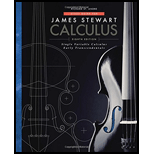
Study Guide for Stewart's Single Variable Calculus: Early Transcendentals, 8th
8th Edition
ISBN: 9781305279148
Author: Stewart, James, St. Andre, Richard
Publisher: Cengage Learning
expand_more
expand_more
format_list_bulleted
Concept explainers
Textbook Question
Chapter 2.8, Problem 1PT
True or False:
f(x) = tan x is differentiable at
Expert Solution & Answer
To determine
Whether the statement “
Answer to Problem 1PT
The given statement is
Explanation of Solution
The derivative of
The function is differentiable at x means that
Compute the value of
Clearly,
Hence,
That is,
Therefore, the statement “
Want to see more full solutions like this?
Subscribe now to access step-by-step solutions to millions of textbook problems written by subject matter experts!
Students have asked these similar questions
Consider the function f(x) = x²-1.
(a) Find the instantaneous rate of change of f(x) at x=1 using the definition of the derivative.
Show all your steps clearly.
(b) Sketch the graph of f(x) around x = 1. Draw the secant line passing through the points on the
graph where x 1 and x->
1+h (for a small positive value of h, illustrate conceptually). Then,
draw the tangent line to the graph at x=1. Explain how the slope of the tangent line relates to the
value you found in part (a).
(c) In a few sentences, explain what the instantaneous rate of change of f(x) at x = 1 represents in
the context of the graph of f(x). How does the rate of change of this function vary at different
points?
1. The graph of ƒ is given. Use the graph to evaluate each of the following values. If a value does not exist,
state that fact.
и
(a) f'(-5)
(b) f'(-3)
(c) f'(0)
(d) f'(5)
2. Find an equation of the tangent line to the graph of y = g(x) at x = 5 if g(5) = −3 and g'(5)
=
4.
-
3. If an equation of the tangent line to the graph of y = f(x) at the point where x 2 is y = 4x — 5, find ƒ(2)
and f'(2).
Does the series converge or diverge
Chapter 2 Solutions
Study Guide for Stewart's Single Variable Calculus: Early Transcendentals, 8th
Ch. 2.1 - Prob. 1PTCh. 2.1 - Prob. 2PTCh. 2.1 - Prob. 3PTCh. 2.1 - True or False:
The slope of a tangent line may be...Ch. 2.2 - Prob. 1PTCh. 2.2 - Prob. 2PTCh. 2.2 - Prob. 3PTCh. 2.2 - Prob. 4PTCh. 2.2 - Prob. 5PTCh. 2.2 - Prob. 6PT
Ch. 2.2 - True or False: The graph in question 3 has a...Ch. 2.3 - Prob. 1PTCh. 2.3 - Prob. 2PTCh. 2.3 - Prob. 3PTCh. 2.3 - Prob. 4PTCh. 2.3 - Prob. 5PTCh. 2.3 - Prob. 6PTCh. 2.3 - Prob. 7PTCh. 2.4 - Prob. 1PTCh. 2.4 - Prob. 2PTCh. 2.4 - Prob. 3PTCh. 2.4 - Prob. 4PTCh. 2.5 - Sometimes, Always, or Never: If limxaf(x) and f(a)...Ch. 2.5 - Prob. 2PTCh. 2.5 - Prob. 3PTCh. 2.5 - Prob. 4PTCh. 2.5 - Prob. 5PTCh. 2.5 - Prob. 6PTCh. 2.6 - Prob. 1PTCh. 2.6 - Prob. 2PTCh. 2.6 - Prob. 3PTCh. 2.6 - Prob. 4PTCh. 2.6 - Prob. 5PTCh. 2.6 - Prob. 6PTCh. 2.6 - Prob. 7PTCh. 2.6 - Prob. 8PTCh. 2.6 - Prob. 9PTCh. 2.7 - Prob. 1PTCh. 2.7 - The slope of the tangent line to y = x3 at x = 2...Ch. 2.7 - Prob. 3PTCh. 2.7 - Prob. 4PTCh. 2.7 - Prob. 5PTCh. 2.7 - Prob. 6PTCh. 2.7 - Prob. 7PTCh. 2.7 - Prob. 8PTCh. 2.7 - Prob. 9PTCh. 2.7 - Which is the largest? a) f(a) b) f(b) c) f(c) d)...Ch. 2.8 - True or False: f(x) = tan x is differentiable at...Ch. 2.8 - Prob. 2PTCh. 2.8 - Prob. 3PTCh. 2.8 - Prob. 4PT
Knowledge Booster
Learn more about
Need a deep-dive on the concept behind this application? Look no further. Learn more about this topic, calculus and related others by exploring similar questions and additional content below.Similar questions
- Suppose that a particle moves along a straight line with velocity v (t) = 62t, where 0 < t <3 (v(t) in meters per second, t in seconds). Find the displacement d (t) at time t and the displacement up to t = 3. d(t) ds = ["v (s) da = { The displacement up to t = 3 is d(3)- meters.arrow_forwardLet f (x) = x², a 3, and b = = 4. Answer exactly. a. Find the average value fave of f between a and b. fave b. Find a point c where f (c) = fave. Enter only one of the possible values for c. c=arrow_forwardplease do Q3arrow_forward
- Use the properties of logarithms, given that In(2) = 0.6931 and In(3) = 1.0986, to approximate the logarithm. Use a calculator to confirm your approximations. (Round your answers to four decimal places.) (a) In(0.75) (b) In(24) (c) In(18) 1 (d) In ≈ 2 72arrow_forwardFind the indefinite integral. (Remember the constant of integration.) √tan(8x) tan(8x) sec²(8x) dxarrow_forwardFind the indefinite integral by making a change of variables. (Remember the constant of integration.) √(x+4) 4)√6-x dxarrow_forward
- a -> f(x) = f(x) = [x] show that whether f is continuous function or not(by using theorem) Muslim_mathsarrow_forwardUse Green's Theorem to evaluate F. dr, where F = (√+4y, 2x + √√) and C consists of the arc of the curve y = 4x - x² from (0,0) to (4,0) and the line segment from (4,0) to (0,0).arrow_forwardEvaluate F. dr where F(x, y, z) = (2yz cos(xyz), 2xzcos(xyz), 2xy cos(xyz)) and C is the line π 1 1 segment starting at the point (8, ' and ending at the point (3, 2 3'6arrow_forward
arrow_back_ios
SEE MORE QUESTIONS
arrow_forward_ios
Recommended textbooks for you

Differential Equation | MIT 18.01SC Single Variable Calculus, Fall 2010; Author: MIT OpenCourseWare;https://www.youtube.com/watch?v=HaOHUfymsuk;License: Standard YouTube License, CC-BY